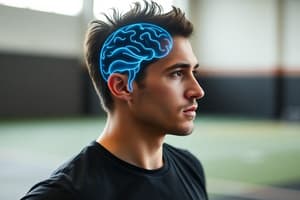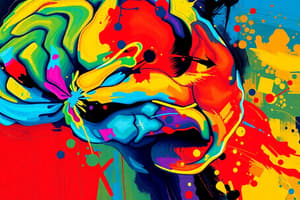Podcast
Questions and Answers
What are the two main muscle fiber types?
What are the two main muscle fiber types?
- Type I and Type III
- Type II and Type III
- Type II and Type IV
- Type I and Type II (correct)
Which system is responsible for controlling involuntary functions such as heart rate and digestion?
Which system is responsible for controlling involuntary functions such as heart rate and digestion?
- Central nervous system
- Somatic nervous system
- Autonomic nervous system (correct)
- Peripheral nervous system
What is the role of the muscle spindle in proprioception?
What is the role of the muscle spindle in proprioception?
- To detect changes in muscle tension
- To detect changes in joint velocity
- To detect changes in joint position
- To detect changes in muscle length (correct)
Which of the following is NOT one of the six components of Postural Control?
Which of the following is NOT one of the six components of Postural Control?
What is the term for the process by which the brain changes and adapts in response to new experiences?
What is the term for the process by which the brain changes and adapts in response to new experiences?
Which of the following is NOT a stage of growth and development in physical, cognitive, and psychosocial domains from 5-12 years of age?
Which of the following is NOT a stage of growth and development in physical, cognitive, and psychosocial domains from 5-12 years of age?
What is the term for the persistent symptoms that can occur after a concussion?
What is the term for the persistent symptoms that can occur after a concussion?
What are the two types of neuroplasticity?
What are the two types of neuroplasticity?
Which of the following is NOT one of the sensory receptors for touch, pain, temperature, and visceral sensation?
Which of the following is NOT one of the sensory receptors for touch, pain, temperature, and visceral sensation?
What is the term for the ability to perceive the position and movement of our own body parts?
What is the term for the ability to perceive the position and movement of our own body parts?
Which of the following is NOT one of the three different levels of the brain that interact with each other for motor control?
Which of the following is NOT one of the three different levels of the brain that interact with each other for motor control?
What is the term for the ability to continue performing a task despite feeling tired?
What is the term for the ability to continue performing a task despite feeling tired?
Which system is responsible for controlling involuntary functions such as heart rate and digestion?
Which system is responsible for controlling involuntary functions such as heart rate and digestion?
What is the role of the muscle spindle in proprioception?
What is the role of the muscle spindle in proprioception?
Which of the following is NOT one of the six components of Postural Control?
Which of the following is NOT one of the six components of Postural Control?
What is the term for the process by which the brain changes and adapts in response to new experiences?
What is the term for the process by which the brain changes and adapts in response to new experiences?
Which of the following is NOT a stage of growth and development in physical, cognitive, and psychosocial domains from 5-12 years of age?
Which of the following is NOT a stage of growth and development in physical, cognitive, and psychosocial domains from 5-12 years of age?
What is the term for the persistent symptoms that can occur after a concussion?
What is the term for the persistent symptoms that can occur after a concussion?
What are the two types of neuroplasticity?
What are the two types of neuroplasticity?
Which of the following is NOT one of the sensory receptors for touch, pain, temperature, and visceral sensation?
Which of the following is NOT one of the sensory receptors for touch, pain, temperature, and visceral sensation?
What is the term for the ability to perceive the position and movement of our own body parts?
What is the term for the ability to perceive the position and movement of our own body parts?
Which of the following is NOT one of the three different levels of the brain that interact with each other for motor control?
Which of the following is NOT one of the three different levels of the brain that interact with each other for motor control?
What is the term for the ability to continue performing a task despite feeling tired?
What is the term for the ability to continue performing a task despite feeling tired?
What is the role of the golgi tendon in movement?
What is the role of the golgi tendon in movement?
What is the difference between muscle strength and muscle power?
What is the difference between muscle strength and muscle power?
What is proprioception?
What is proprioception?
What is the role of the somatosensory system?
What is the role of the somatosensory system?
What is postural control?
What is postural control?
What is neuroplasticity?
What is neuroplasticity?
What are the components of fatiguability?
What are the components of fatiguability?
What is the pathophysiology of concussion?
What is the pathophysiology of concussion?
What are the six components of postural control?
What are the six components of postural control?
What is the function of mirror neurons?
What is the function of mirror neurons?
What is the role of the muscle spindle in proprioception?
What is the role of the muscle spindle in proprioception?
What are the stages of growth and development in physical, cognitive and psychosocial domains from 5 – 12 years of age?
What are the stages of growth and development in physical, cognitive and psychosocial domains from 5 – 12 years of age?
What is the function of the cerebellum within the central nervous system?
What is the function of the cerebellum within the central nervous system?
What is the difference between muscle strength and muscle power?
What is the difference between muscle strength and muscle power?
What is proprioception?
What is proprioception?
What is alpha-gamma co-activation and its role in movement?
What is alpha-gamma co-activation and its role in movement?
What is the golgi tendon and its role in movement?
What is the golgi tendon and its role in movement?
What are the six components of Postural Control?
What are the six components of Postural Control?
What are the stages of development for the fundamental movement skills?
What are the stages of development for the fundamental movement skills?
What is the dynamic systems approach to growth and development?
What is the dynamic systems approach to growth and development?
What are some common tests of balance for older people?
What are some common tests of balance for older people?
What is Long Term Potentiation (LTP) and Long Term Depression (LTD)?
What is Long Term Potentiation (LTP) and Long Term Depression (LTD)?
What are the different types of memory?
What are the different types of memory?
What is chronic traumatic encephalopathy (CTE)?
What is chronic traumatic encephalopathy (CTE)?
What is the function of the cerebellum in the central nervous system?
What is the function of the cerebellum in the central nervous system?
What is the difference between muscle strength and muscle power?
What is the difference between muscle strength and muscle power?
What is proprioception?
What is proprioception?
What is alpha-gamma co-activation?
What is alpha-gamma co-activation?
What is the golgi tendon and its role in movement?
What is the golgi tendon and its role in movement?
What are the six components of Postural Control?
What are the six components of Postural Control?
What is a dynamic systems approach to growth and development?
What is a dynamic systems approach to growth and development?
What are the different types of memory?
What are the different types of memory?
What is the term for the ability to continue performing a task despite feeling tired?
What is the term for the ability to continue performing a task despite feeling tired?
What is chronic traumatic encephalopathy (CTE)?
What is chronic traumatic encephalopathy (CTE)?
What are common tests of balance for older people?
What are common tests of balance for older people?
What are the conditions that help to promote neuroplasticity in learning new skills and recovery from injury?
What are the conditions that help to promote neuroplasticity in learning new skills and recovery from injury?
What is the function of the cerebellum in the central nervous system?
What is the function of the cerebellum in the central nervous system?
What is the difference between muscle strength and muscle power?
What is the difference between muscle strength and muscle power?
What is proprioception?
What is proprioception?
What is the role of the golgi tendon in movement?
What is the role of the golgi tendon in movement?
What are the six components of Postural Control?
What are the six components of Postural Control?
What is the dynamic systems approach to growth and development?
What is the dynamic systems approach to growth and development?
What is a fundamental movement skill?
What is a fundamental movement skill?
What are some common tests of balance for older people?
What are some common tests of balance for older people?
What is Long Term Potentiation (LTP)?
What is Long Term Potentiation (LTP)?
What is the difference between short-term memory and long-term memory?
What is the difference between short-term memory and long-term memory?
What is chronic traumatic encephalopathy (CTE)?
What is chronic traumatic encephalopathy (CTE)?
What is sense of effort?
What is sense of effort?
Flashcards are hidden until you start studying
Study Notes
Neuroscience in Sports Science Quiz
- Identify the divisions of the nervous system: central and peripheral nervous systems.
- Explain the function of major structures within the central nervous system: cerebrum, cerebellum, brainstem, and spinal cord.
- Define muscle strength and muscle power, and explain how muscle fiber type influences muscle strength and endurance.
- Describe the sensory receptors for touch, pain, temperature, and visceral sensation, and define proprioception.
- Explain alpha-gamma co-activation and its role in movement, and describe the golgi tendon and its role in movement.
- Describe the six components of Postural Control and how they contribute to Postural Control.
- Discuss the stages of growth and development in physical, cognitive, and psychosocial domains from 5-12 years of age using a dynamic systems approach.
- Explain the stages of development for the fundamental movement skills and select one example to demonstrate your knowledge.
- Describe common tests of balance and safety considerations for older people and the importance of falls prevention and community engagement for older people.
- Discuss the neurophysiological mechanisms by which Long Term Potentiation and Long Term Depression occur and the conditions that help to promote neuroplasticity in learning new skills and recovery from injury.
- Describe the different types of memory and how information processing impacts on motor control.
- Define and describe concussion, post-concussion syndrome, subconcussion, and chronic traumatic encephalopathy (CTE), and understand sense of effort.
Neuroscience in Sports Science Quiz
- Identify the divisions of the nervous system: central and peripheral nervous systems.
- Explain the function of major structures within the central nervous system: cerebrum, cerebellum, brainstem, and spinal cord.
- Define muscle strength and muscle power, and explain how muscle fiber type influences muscle strength and endurance.
- Describe the sensory receptors for touch, pain, temperature, and visceral sensation, and define proprioception.
- Explain alpha-gamma co-activation and its role in movement, and describe the golgi tendon and its role in movement.
- Describe the six components of Postural Control and how they contribute to Postural Control.
- Discuss the stages of growth and development in physical, cognitive, and psychosocial domains from 5-12 years of age using a dynamic systems approach.
- Explain the stages of development for the fundamental movement skills and select one example to demonstrate your knowledge.
- Describe common tests of balance and safety considerations for older people and the importance of falls prevention and community engagement for older people.
- Discuss the neurophysiological mechanisms by which Long Term Potentiation and Long Term Depression occur and the conditions that help to promote neuroplasticity in learning new skills and recovery from injury.
- Describe the different types of memory and how information processing impacts on motor control.
- Define and describe concussion, post-concussion syndrome, subconcussion, and chronic traumatic encephalopathy (CTE), and understand sense of effort.
Studying That Suits You
Use AI to generate personalized quizzes and flashcards to suit your learning preferences.





